Self-Tracking Meets Ready-To-Wear: Make Room in Your Closet for Smart Clothes

Your LBD (little black dress) is about to be joined in your closet by a SWD (smart wearable device). The worlds of electronics and textiles are becoming interwoven and the results are going to profoundly impact your health. Here’s what you need to know about e-textiles and smart fabrics and a preview of the clothes, shoes, and accessories that may soon find their way into your closet.
E-Fashionista Vocabulary
Just when you thought you’d finally gotten a handle on terms like ruching, GORE-TEX, and tulle, along comes a whole new fashion lexicon. Forget about SmartWool. We now have smart fabrics and smart clothes. And intelligent textiles, interactive textiles, interactive clothing, and wearable computing. And e-fabrics, e-textiles, e-fibers, and e-broidery.
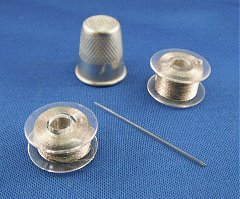 E-textile is short for electronic- or electro- textile. E-textiles are essentially fabrics with electronics and other components that are embedded in, or intrinsic to, the fabric such that the fabric maintains its key properties, like draping. (Shown, conductive silver plated nylon thread)
E-textile is short for electronic- or electro- textile. E-textiles are essentially fabrics with electronics and other components that are embedded in, or intrinsic to, the fabric such that the fabric maintains its key properties, like draping. (Shown, conductive silver plated nylon thread)
Smart fabrics are generally defined as, well, smart. This means a fabric can not only sense the environment, but also react to it. Scenarios include a fabric that warms you when you’re cold, cleans itself when it’s dirty (hooray!), lights up to ensure you’re visible when it’s dark, and automatically stiffens to protect you when you’re falling. Smart clothes could monitor your fitness parameters as you train and give you advice to modify your workout, during your workout. And of course smart clothes would recharge your mobile device while it was tucked in your pocket.
Smart clothes and e-textiles offer a second skin to help you understand what goes on under your real skin. They enable you to wear sensors comfortably and unobtrusively to track your physiological signals and your surrounding environmental conditions in real time – anytime, anywhere. They are going to influence the health of patients, the training of athletes, and the safety of fire fighters. And perhaps most significantly, they are going to create an entirely new paradigm of wear, share, and compare.
Form follows function and function follows form
Sensors that detect physiological signals may be embedded or integrated directly into a textile (such as part of a yarn that is woven or knitted into the fabric) or they may be applied on top of the fabric, such as in an ink. Since the sensors are part of the garment, they are usually in direct contact with your skin.
The sensors can detect an amazing range of physiological stimuli from you and your surrounding environment. These include mechanical, thermal, chemical, electrical, optical, and magnetic signals. Once the sensors detect the signal, it’s collected, processed, stored and transmitted.
The potential of e-textiles and smart clothes is best demonstrated by applications in two key areas: health/medical and sports/professional performance and safety. These niches tend to be where cutting-edge development occurs and thus are good indicators of products and technology that may move mainstream (for further discussion on this, see Self-tracking, Sensors, and mHealth: Trends and Opportunities). Here are examples of just a few of the many really cool products that are in various stages of commercialization and development.
Under pressure: Under Armour E39 electronic compression shirt
The Under Armour E39 shirt, developed through a partnership with Zephyr Technology (which makes the BioHarness), features a removable electronic monitor, or “bug.” 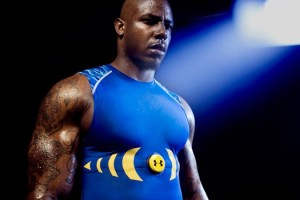 The bug is a combined sensor pack, processor, and hard drive that plugs into the shirt. The sensor measures heart rate, breathing rate, skin surface temperature, and triaxial (3 axes – X, Y, Z – thus three dimensional) accelerometry. Sensor data can be sent via Bluetooth to smart phones and laptops for viewing by coaches and friends. The E39 shirt debuted at the NFL Scouting Combine in February, 2011 and is expected to be available to the public in 2012. (photo from Under Armour)
The bug is a combined sensor pack, processor, and hard drive that plugs into the shirt. The sensor measures heart rate, breathing rate, skin surface temperature, and triaxial (3 axes – X, Y, Z – thus three dimensional) accelerometry. Sensor data can be sent via Bluetooth to smart phones and laptops for viewing by coaches and friends. The E39 shirt debuted at the NFL Scouting Combine in February, 2011 and is expected to be available to the public in 2012. (photo from Under Armour)
A real kick: The adidas adizero f50 powered by miCoach
Marketed as the “football boot with a brain,” the adidas adizero f50 soccer shoe contains a space in the outsole (bottom) to tuck a miCoach Speed Cell. This tracking device captures performance metrics such as speed, maximum speed, number of sprints, distance, steps and stride rates. The data are stored and can be wirelessly uploaded to a PC, Mac or smart phone so you can share and compare your stats with friends or adidas professional players. 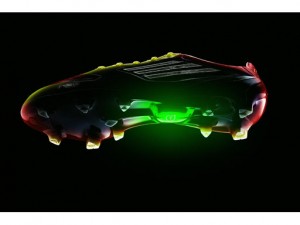 The shoes and speed cell/USB adaptor are sold separately or as a bundle (available in November [ADDED NOTE: became available Nov 11]). The sensor device has been designed to be compatible with other adidas footwear. Expect a related miCoach online football (soccer) video game in 2012. (photo courtesy of adidas)
The shoes and speed cell/USB adaptor are sold separately or as a bundle (available in November [ADDED NOTE: became available Nov 11]). The sensor device has been designed to be compatible with other adidas footwear. Expect a related miCoach online football (soccer) video game in 2012. (photo courtesy of adidas)
Reebok and mc10: Flexible electronics
Reebok is collaborating with mc10 to create intelligent sports equipment and apparel. Based on research by John Rogers of UIUC and George Whitesides of Harvard, mc10 develops thin “conformal” electronics that can bend and stretch and that can be imbedded into materials such as paper, fabric, latex, and leather. This is definitely a partnership that bears close, um, tracking.
Smarty pants: Printing biometric sensors on underwear
 What better place to put sensors than the elastic band of your underwear? This location enables sensors to be in direct and continuous contact with the skin. Researchers have screen-printed amperometric carbon sensor arrays directly onto the elastic band of underwear. The sensors survive repetitive stretching, pulling, and folding. The sensors can measure hydrogen peroxide and NADH, and could potentially monitor chemicals found in sweat through dehydrogenase- and oxidase-based enzyme sensors (for example, ethanol and lactate). Applications include healthcare, sport, and military monitoring. (Image from the Royal Society of Chemistry)
What better place to put sensors than the elastic band of your underwear? This location enables sensors to be in direct and continuous contact with the skin. Researchers have screen-printed amperometric carbon sensor arrays directly onto the elastic band of underwear. The sensors survive repetitive stretching, pulling, and folding. The sensors can measure hydrogen peroxide and NADH, and could potentially monitor chemicals found in sweat through dehydrogenase- and oxidase-based enzyme sensors (for example, ethanol and lactate). Applications include healthcare, sport, and military monitoring. (Image from the Royal Society of Chemistry)
PSYCHE Project: Updating the mood ring
The PSYCHE (Personalized monitoring SYstems for Care in mental HEalth) project aims to develop a cost-effective, continuous portable monitoring system for patients affected by mood disorders, such as bipolar illness. The goals of the project are to empower patients to proactively monitor their mood status in order to predict, detect and manage critical events and health issues; to improve patient-physician interaction; and to alert physicians in case of depressive or manic episodes. This system is currently being implemented and validated technically, functionally, and clinically.
Potential measurements include:
- Physiological: heart rate (electrocardiogram, ECG), respiratory rate, movement, galvanic skin resistance, brain wave activity (electroencephalogram, EEG), eye activity (electrooculogram, EOG), blood pressure, body temperature
- Biochemical: levels of prescribed drugs such as lithium; glucose, cholesterol, triglycerides and other indicators of metabolic disorders that can develop as a side effect of medication use
- Behavioral: obtained from correlating biochemical measures, voice analysis, and a behavioral index
Potential features include data that are collected along with “subjective annotations” and then integrated into an electronic health record (EHR) with information such as medication; measurement of both thoracic and abdominal respiration through textile sensors, thus potentially offering a mechanism for biofeedback training exercises; and night monitoring of heart rate, breathing rate and ambient conditions (temperature, light, noise) to deduce sleep status, which could be combined with sensorized bed sheets.
Sensors that fit like a glove
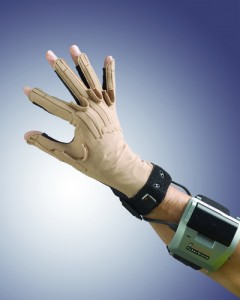 How do you measure hand function in individuals that have a neurological disorder? With an instrumented glove. Researchers have developed a glove that measures finger and wrist flexion based on bend sensors that contain a carbon/polymer-based ink whose resistance increases with bending. Finger movements can be measured while the user is performing specific tasks, and even slight changes in fine motor skills can be detected.
How do you measure hand function in individuals that have a neurological disorder? With an instrumented glove. Researchers have developed a glove that measures finger and wrist flexion based on bend sensors that contain a carbon/polymer-based ink whose resistance increases with bending. Finger movements can be measured while the user is performing specific tasks, and even slight changes in fine motor skills can be detected.
Several commercialized, instrumented gloves are already available, mainly for virtual reality and computer gaming:
- CyberGlove II (shown)
- P5 Glove
- The Peregrine glove
- Nintendo Power Glove (vintage video commercial)
A vested interest in congestive heart failure patients and Mount Everest climbers
Leave it to a group of Italian researchers to develop a vest that perfectly marries form and function. The MagIC (Maglietta Interattiva Computerizzata) is a vest with embedded sensors made of conductive fibers to measure heart rate and breathing rate, and an electronic module with a triaxial accelerometer, data storage, and signal transmission. The washable vest comes in several sizes, is specifically tailored to minimize artifacts, and has a front or side opening with Velcro or a zipper so it can be worn by people with impaired movement.
 The garment has been validated in several diverse telemedicine applications. In one scenario, patients with congestive heart failure who had recently been discharged from the hospital wore the vest in their homes for a few minutes each day for a month. The data were viewed remotely by a cardiologist. Patients reported that the garment was comfortable and that they felt “safely supervised.” The patients actually requested to continue the monitoring period!
The garment has been validated in several diverse telemedicine applications. In one scenario, patients with congestive heart failure who had recently been discharged from the hospital wore the vest in their homes for a few minutes each day for a month. The data were viewed remotely by a cardiologist. Patients reported that the garment was comfortable and that they felt “safely supervised.” The patients actually requested to continue the monitoring period!
In a more extreme scenario, climbers wore the vest on a Mount Everest expedition. The vest was made of polypropylene instead of cotton, and the position of the electronic module was moved higher up so it didn’t interfere with the climber’s backpack belts. Measurements were collected during the day and during sleep. Again, the vest was comfortable and provided accurate real-life telemonitoring. (Image from Istituto Auxologico Italiano)
The ProeTEX Project: Fighting fire with wire
The ProeTEX project is a tour de force of sensor technology and usability. The goal is to develop e-textiles for emergency disaster personnel in order to improve their safety. End-users, such as fire fighters, are part of the project team, and specific operative scenarios were deployed as part of the process to develop several garment prototypes.
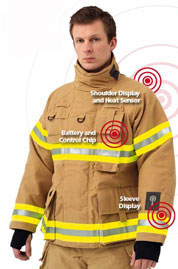 T-shirt or inner garment: This assesses the health status of the emergency worker through measurement of physiological parameters. An elastic region contains textile electrodes for measurement of heart rate, as well as a body temperature sensor. Sensors for blood oxygen saturation (SpO2) and sodium (Na+) can also be integrated. A detachable band contains a piezoelectric breathing rate sensor and the electronic modules. Since this garment is in contact with the user’s skin, comfort is considered a key design feature.
T-shirt or inner garment: This assesses the health status of the emergency worker through measurement of physiological parameters. An elastic region contains textile electrodes for measurement of heart rate, as well as a body temperature sensor. Sensors for blood oxygen saturation (SpO2) and sodium (Na+) can also be integrated. A detachable band contains a piezoelectric breathing rate sensor and the electronic modules. Since this garment is in contact with the user’s skin, comfort is considered a key design feature.
Jacket or outer garment (shown): This monitors the user’s activity state and the surrounding environment. There are two triaxial accelerometers. One at the collar detects inactivity and falls to the ground and one at the wrist also detects inactivity. Together they provide a estimation of body inclination. A textile motion sensor located in the elbow region provides redundancy in measuring user movement. A carbon oxide sensor is located in the lapel area, near the user’s mouth and nose. There’s also an external temperature sensor, a heat flux sensor, and a GPS antenna, as well as a visual alarm and acoustic alarm to warn the user of detected dangers. The jacket contains electronics for data storage and transmission.
Boots: At the request of the end users, the boots contain sensors to measure the concentration of toxic gases, like carbon dioxide (CO2), that are heavier than air and accumulate at ground level. The boots also monitor the contact of the foot with the ground, thus tracking the activity of the user.
The data from all the sensors are recorded in a device located in the jacket and transmitted wirelessly to a remote post where all the parameters of the emergency personnel can be monitored in real time.
(Image from ProeTEX)
ProeTEX is one of many Smart Fabrics, Interactive Textile (SFIT) projects funded by the European Commission and conducted by a large consortium of European partners that includes universities, research centers, medical hospitals, and industry. Other projects include MyHeart, BIOTEX, STELLA, and OFSETH.
Sensor Accessories = Sencessories
While there are amazing e-textile garments commercially available and in development, what any true-blue fashionista knows is that accessorizing is what really matters. Forget about watches that resemble a car dashboard duct-taped to your wrist.  Companies are now developing sleek sencessories, such as the Jawbone UP (shown), a motion sensing band that tracks your movement (or your lack of movement) using technology from MotionX.
Companies are now developing sleek sencessories, such as the Jawbone UP (shown), a motion sensing band that tracks your movement (or your lack of movement) using technology from MotionX.
Imagine sencessories such as cuff links, earrings, a brooch, belt, bracelet, tie bar, pendant, finger ring or toe ring that you can mix and match to monitor your heart rate, breathing rate, blood glucose, calories burned, and ambient air quality. What sencessory would you most like to sport?
DIY e-textile Fashion
Do you love hardware stores and Project Runway? There are a number of Do-It-Yourself sites where you can create your own sartorial sensor splendor.
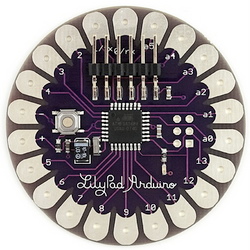 LilyPad Arduino (shown): a set of sewable electronic components (see the LilyPad Arduino Flickr group for ideas)
LilyPad Arduino (shown): a set of sewable electronic components (see the LilyPad Arduino Flickr group for ideas)- Plug and Wear: tutorials and supplies
- Textronics developers kit
- Lynne Bruning on the e-Textile Lounge and wearable computing (video)
- KOBAKANT DIY Wearable Technology
Wear, Share, Compare
E-textiles and smart clothes are going to revolutionize virtual data sharing communities. In the sports world, you’ll be able to compare your data against the data of your drinking buddies and your favorite pro athletes. Polar provided live race data during the Tour de France and Guinness Rugby has put RFID chips into rugby balls and player jerseys. Expect to see more live tracking of pro athletes during major sporting events (see STATS SportVU video for examples), as well as integration and gamification with fantasy sports leagues and video games.
On the medical side of the spectrum, you’ll be able to share your data in real time with your PHR and with health care providers, giving you the ability to leave a hospital early, or even to just leave a hospital room. E-textile data will be shared in existing online communities such as Patients Like Me and Cure Together, and will provide the base for new communities. The data are going to drive new research paradigms and help us better understand the connection between our health and our environment.
Dress for Success
As you can imagine, there are numerous challenges to overcome when designing e-textiles:
- The sensors need to be accurate, reliable, sensitive, specific, low cost, reproducible, have a short analysis time, a high signal to noise ratio (low motion artifacts), and work over a wide range of temperatures.
- The clothes need to maintain their key properties, such as bending, stretching and drapability. They should also be washable, long lasting, light weight, and should be easy to put on and off if they are going to be worn by people with disabilities.
When it comes to health applications, it’s especially important to pause and consider user context. Life is not ‘one-size-fits-all’ and smart clothes shouldn’t be, either. To be successful, e-textile garments will need to:
- be based on need, not driven by technology
- be comfortable and affordable
- be intuitive to use
- be integrated with health care providers and systems as appropriate
- improve the wearer’s quality of life.
This is a very hot field and there will be incredible developments in the future. Watch for:
- sensors that detect not only what goes on under your skin, but also on your skin. Imagine tracking your skin microbiome to better gauge your health status and disease risks
- advances in data analytics to identify trends and anticipate critical events (imagine being able to predict an epileptic seizure or migraine)
- sensor tattoos
- utilizing data for real-time personal biofeedback training, such as stress reduction
- harvesting or scavenging energy from your body to power your smart clothes. Energy sources include your breath, blood flow, body heat, and foot strike during walking.
Research in e-textiles may also lead to new insights in clothing design for individuals with various medical needs that have not yet been recognized, let alone addressed. There is customized clothing for women who have undergone mastectomies, people with an ostomy or stoma, and individuals with Down’s Syndrome. What’s missing? What would you like to see redesigned? And how can we best reinvent the hospital gown?
Clothes are our second skin. They let us express who we are. Our relationship with our clothes will grow even more personal in the future as they not only track our physiological and environmental status, but also react to protect us and serve to connect us.
What smart garment would you most like to have hanging in your closet?
More e-textiles:
- Georgia Tech Wearable Motherboard™ (GTWM) This is one of the first smart shirts. It was developed in the 1990s with funding from the U.S. Department of Navy.
- The LifeShirt System (no longer available for sale)
- Somnus Sleep Shirt Night shirt that analyzes breathing patterns
- “Intelligent” t- shirt Washable garment monitors ECG, body temperature and position. Developed by researchers at Carlos III University in Madrid.
- e-textile pants assess stability in the elderly
- Body suit for fetal monitoring during pregnancy
- Le Chal: A haptic feedback based shoe for the blind
Smart reads on Smart textiles
- Smart Textiles Blend LEDs, Circuits and Sensors (Priya Ganapati, Gadget Lab)
- Fashioningtech.com Syuzi Pakhchyan (blog, forum, resources)
- Innovation In Textiles (news and technical resource for the global technical textiles industry)
- International Symposium on Wearable Computers (ISWC)
Related posts
- Self-tracking, Sensors, and mHealth: Trends and Opportunities (big list of resources)
- mHealth Summit 2010: A context check list
- The mHealth Summit: Local & Global Converge
- mHealth: Health where you live, work, and play
- Self-tracking: Checking under the hood
- 7 Health 2.0 Trends for 2011









[…] Self-Tracking Meets Ready-To-Wear: Make Room in Your Closet for Smart Clothes […]
[…] Self-Tracking Meets Ready-To-Wear: Make Room in Your Closet for Smart Clothes […]
[…] Self-Tracking Meets Ready-To-Wear: Make Room in Your Closet for Smart Clothes […]
[…] Self-Tracking Meets Ready-To-Wear: Make Room in Your Closet for Smart Clothes […]
[…] Self-tracking meets ready-to-wear: Make room in your closet for smart clothes […]
[…] Self-tracking meets ready-to-wear: Make room in your closet for smart clothes […]
[…] Self-tracking meets ready-to-wear: Make room in your closet for smart clothes […]
[…] Self-tracking meets ready-to-wear: Make room in your closet for smart clothes […]
Wow, really interesting article. Im currently looking into this field in relation to a college project I’m doing. The project is based in 2030 and i am trying to design something to monitor the well being of elderly without being invasive. You have confirmed what i was already thinking, that this field is going to explode in the future. Thanks for the help!
Robert, thanks for your comment. This field is moving very fast, especially in the area of caregiving. I highly recommend you read a new post from Neil Versel over at MobiHealthNews, called ‘Panic buttons for seniors must go.’ http://mobihealthnews.com/19397/panic-buttons-for-seniors-must-go/ (also take a look through their great site). For more ideas, I have a Wearable Tech Pinterest board, http://pinterest.com/caroltpin/wearable-tech/
Good luck with your project – I would be very interested in learning what you end up doing for it.
Carol
[…] Self-tracking meets ready-to-wear: Make room in your closet for smart clothes […]
[…] can my contact lenses or my smart-clothes / e-textiles / wearable technology tell me about my health and […]
[…] Self-tracking meets ready-to-wear: Make room in your closet for smart clothes […]
[…] Self-tracking meets ready-to-wear: Make room in your closet for smart clothes […]
[…] Self-tracking meets ready-to-wear: Make room in your closet for smart clothes […]
[…] spotted the self-tracking-meets-ready-to-wear trend in her blog post written back on November 6, 2011. She’s also tracked health wearables on her voluminous […]
[…] Self-tracking meets ready-to-wear: Make room in your closet for smart clothes […]
[…] Self-tracking meets ready-to-wear: Make room in your closet for smart clothes […]
[…] if Wearable Tech was like Press-on Nails? Battle of the Bands: Jawbone UP Vs. 3M Tegaderm Band-Aid Self-tracking meets ready-to-wear: Make room in your closet for smart clothes Is your activity tracking gadget accurate? Do you care? Leonardo Da Vinci Meets Wearable Tech: A […]
[…] if Wearable Tech was like Press-on Nails? Battle of the Bands: Jawbone UP Vs. 3M Tegaderm Band-Aid Self-tracking meets ready-to-wear: Make room in your closet for smart clothes Is your activity tracking gadget accurate? Do you […]
[…] Self-tracking meets ready-to-wear: Make room in your closet for smart clothes […]
[…] popular posts Is your activity tracking gadget accurate? Do you care? Self-tracking meets ready-to-wear: Make room in your closet for smart clothes The Future of Activity Monitoring: Innovating Beyond Steps, Sleep, and Speed What if Wearable Tech […]